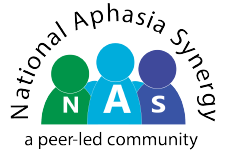About Aphasia
What is Aphasia?
Aphasia is a language disorder due to a stroke, brain injury, brain tumor or surgery, brain infection or neurological disease. A person with aphasia (PWA) may have difficulty speaking, reading, writing, and understanding, but judgment and intelligence are intact - an invisible disability. No two people with aphasia are ever exactly alike and there is a range of various forms of aphasia. Definitions and the common types of aphasia link:
Aphasia.org
How common is aphasia?
It is more common than you may think:
- It affects well over 2 million people in the U.S.
- The number of people in the U.S with aphasia is more than the combined population of Wyoming, Vermont & Alaska
- Aphasia affects approximately 1 in every 3 stroke survivors.
- There are about 150 times more people with aphasia than there are people with ALS.
It is common that people with aphasia:
- May pause a lot. The word may be on the tip of their tongue, but they are unable to access it in that moment.
- May say yes and no when they mean the opposite. This can make it difficult, as answers may be unreliable.
- May have difficulties with numbers, times, and dates and need more time to comprehend.
- May have difficulty with excessive noises or background noises.
- May have difficulty with choices, such as choices of salad dressings offered by a restaurant waiter.
How can you help with communication?

- Be patient and wait for a response.
- Reduce background noise (TV, radio, other people).
- Speak simply and directly to me.
- Say one thing at a time.
- Ask yes/no questions.
- Write down key words (names, places, numbers).
- Gesture, draw diagrams or pictures.
- Relax and be natural.
- Don’t pretend you understand.
- Recap and check that you both understand.




